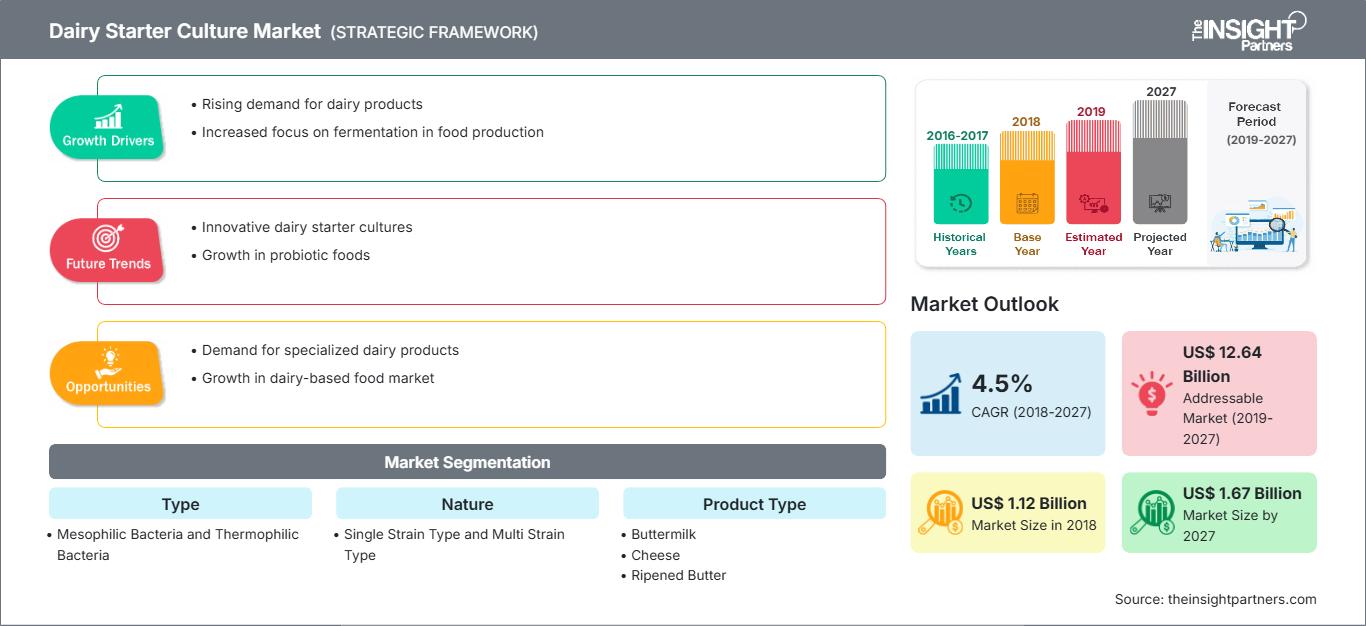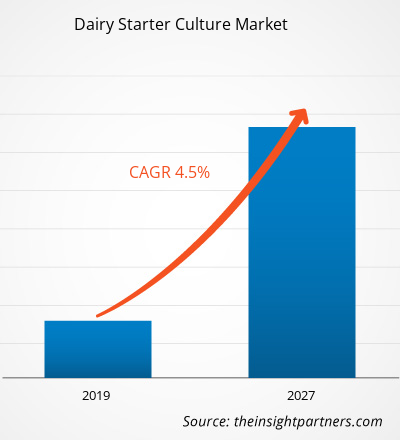[Rapporto di ricerca]Il mercato delle colture starter lattiero-casearie è stato valutato a 1.124,3 milioni di dollari nel 2018 e si prevede che raggiungerà i 1.670,2 milioni di dollari entro il 2027; si prevede una crescita a un CAGR del 4,5% dal 2021 al 2027.
Le colture starter lattiero-casearie si riferiscono ai microrganismi che vengono aggiunti al latte per ottenere una consistenza ottimale del prodotto. Le colture starter lattiero-casearie vengono aggiunte durante il processo di sviluppo e fermentazione dei microrganismi. Inoltre, la produzione di acido lattico dallo zucchero del latte (lattosio) riduce il contenuto di pH, preservando così la densità del latte e alimentando così il mercato globale delle colture starter lattiero-casearie.
Si prevede che il mercato delle colture starter lattiero-casearie in Europa crescerà al CAGR più elevato durante il periodo di previsione. La crescita del mercato in questa regione è principalmente attribuibile all'industria lattiero-casearia consolidata. Diversi tipi di prodotti lattiero-caseari fermentati stanno diventando sempre più popolari in Europa. Germania e Francia sono i principali produttori di prodotti lattiero-caseari, che vanno dal latte al formaggio, e detengono una posizione dominante nell'Unione Europea. Il consumo e la produzione di formaggio nell'Unione Europea hanno avuto un impatto sostanziale sul mercato delle colture starter, fondamentali per prolungare la conservabilità e sostenere le esportazioni verso altre regioni. Le diverse varietà di prodotti lattiero-caseari in Europa sono un fattore chiave che contribuisce alla crescita del mercato attraverso l'impiego di colture in formaggi, prodotti lattiero-caseari fermentati, bevande alcoliche e applicazioni per carne e pesce.
La crescente domanda di colture starter per prodotti lattiero-caseari in Europa ha spinto i produttori a stabilirsi nella regione, alimentando ulteriormente la crescita del mercato delle colture starter per prodotti lattiero-caseari in Europa.
Personalizza questo rapporto in base alle tue esigenze
Potrai personalizzare gratuitamente qualsiasi rapporto, comprese parti di questo rapporto, o analisi a livello di paese, pacchetto dati Excel, oltre a usufruire di grandi offerte e sconti per start-up e università
Mercato delle colture starter lattiero-casearie: Approfondimenti strategici

-
Ottieni le principali tendenze chiave del mercato di questo rapporto.Questo campione GRATUITO includerà l'analisi dei dati, che vanno dalle tendenze di mercato alle stime e alle previsioni.
Il mercato delle colture starter per latticini ha registrato una crescita nominale nel 2020 a causa del COVID-19, seguita da un lieve calo della domanda. Il mercato è stato sconvolto dal COVID-19 a causa del rallentamento della produzione di materie prime, dell'instabilità della catena di approvvigionamento e della chiusura di hotel, ristoranti e bar. Inoltre, la pandemia di COVID-19 in corso ha drasticamente alterato lo stato di crescita del settore delle colture starter per latticini, poiché hotel, ristoranti e bar sono completamente chiusi in molti paesi.
Approfondimenti di mercato
Si prevede che la crescente consapevolezza sanitaria nelle economie emergenti alimenterà la crescita del mercato delle colture starter per latticini
La crescente consapevolezza del mercato e la domanda di prodotti lattiero-caseari sicuri hanno spinto i produttori a realizzare prodotti lattiero-caseari di alta qualità incorporando componenti di colture starter per latticini. L'aggiunta di colture starter lattiero-casearie migliora il sapore, la consistenza e il colore dei prodotti lattiero-caseari, ottenendo la consistenza desiderata. Grazie alla domanda di prodotti lattiero-caseari di alta qualità, si prevede che il mercato delle colture starter lattiero-casearie crescerà significativamente durante il periodo di previsione. Inoltre, grazie ai benefici per la salute derivanti dall'aggiunta di microrganismi starter ai prodotti lattiero-caseari, come la protezione dalle infezioni gastrointestinali, l'effetto anticancerogeno, il sollievo dalla stitichezza, la riduzione del colesterolo sierico, il rafforzamento del sistema immunitario e le proprietà antiallergiche, si prevede che il mercato globale delle colture starter lattiero-casearie crescerà nel prossimo futuro.
Approfondimenti sulla tipologia
In base alla tipologia, il mercato delle colture starter lattiero-casearie si divide in batteri mesofili e batteri termofili. Il segmento dei batteri termofili ha rappresentato una quota di mercato maggiore nel 2018. Un termofilo è una forma di batteri estremofili che prospera a temperature relativamente elevate, comprese tra 41 e 122 °C (tra 106 e 252 °F). I batteri termofili sopravvivono ad alte temperature, mentre altri batteri o archei subiranno danni se non uccisi se esposti alle stesse condizioni. Gli starter termofili abbassano il pH dei prodotti lattiero-caseari, prevenendo la crescita di microrganismi deterioranti e stimolando la sineresi. Sono essenziali nel caso dello yogurt perché conferiscono sapore e consistenza. Pertanto, si prevede che tutti questi fattori contribuiranno a incrementare la domanda di colture starter per latticini durante il periodo di previsione.
Nature Insights
In base alla natura, il mercato delle colture starter per latticini è segmentato in tipo monoceppo e tipo multiceppo. Il segmento multiceppo ha rappresentato la quota di mercato maggiore nel 2018. Il mercato globale delle colture starter per latticini è guidato dal segmento multiceppo. L'uso di diversi ceppi di colture starter prolunga la shelf-life del prodotto e offre una caratteristica di rigonfiamento adatta ai prodotti da forno. Di conseguenza, si prevede che l'uso del segmento multi-ceppo stimolerà la crescita del settore globale delle colture starter per latticini.
Alcuni attori che operano nel mercato delle colture starter per latticini sono BDF Natural Ingredients SL
Biolacter, Inc, Chr. Hansen Holding A/S, CSK food enrichment BV, Dalton Biotecnologie SRL,
Dohler Group, The Dow Chemical Company, Lallemand Inc., LB Bulgaricum e Sacco System, tra molti altri. Le aziende chiave implementano fusioni e acquisizioni e strategie di ricerca e sviluppo per espandere la base clienti e ottenere una quota significativa nel mercato globale, il che consente loro anche di mantenere il proprio marchio a livello globale.
In evidenza nel rapporto
- Tendenze progressive del settore nel mercato delle colture starter lattiero-casearie per aiutare gli operatori a sviluppare strategie efficaci a lungo termine
- Strategie di crescita aziendale adottate dai mercati sviluppati e in via di sviluppo
- Analisi quantitativa del mercato delle colture starter lattiero-casearie dal 2019 al 2027
- Stima della domanda globale di colture starter lattiero-casearie
- Analisi PEST per illustrare l'efficacia di acquirenti e fornitori che operano nel settore
- Sviluppi recenti per comprendere lo scenario competitivo del mercato
- Tendenze e prospettive di mercato, nonché fattori che guidano e frenano la crescita del mercato delle colture starter lattiero-casearie
- Assistenza nel processo decisionale evidenziando le strategie di mercato che sostengono l'interesse commerciale, portando alla crescita del mercato
- La dimensione del Dimensioni del mercato delle colture starter lattiero-casearie in vari nodi
- Panoramica dettagliata e segmentazione del mercato, nonché dinamiche del settore delle colture starter lattiero-casearie
- Dimensioni del mercato delle colture starter lattiero-casearie in varie regioni con promettenti opportunità di crescita
Approfondimenti regionali sul mercato delle colture starter per latticini
Le tendenze regionali e i fattori che influenzano il mercato delle colture starter per latticini durante il periodo di previsione sono stati ampiamente spiegati dagli analisti di The Insight Partners. Questa sezione illustra anche i segmenti e la geografia del mercato delle colture starter per latticini in Nord America, Europa, Asia-Pacifico, Medio Oriente e Africa, America Meridionale e Centrale.
Ambito del rapporto di mercato sulla coltura starter del latte
| Attributo del rapporto | Dettagli |
|---|---|
| Dimensioni del mercato in 2018 | US$ 1.12 Billion |
| Dimensioni del mercato per 2027 | US$ 1.67 Billion |
| CAGR globale (2018 - 2027) | 4.5% |
| Dati storici | 2016-2017 |
| Periodo di previsione | 2019-2027 |
| Segmenti coperti |
By Tipo
|
| Regioni e paesi coperti |
Nord America
|
| Leader di mercato e profili aziendali chiave |
|
Densità degli attori del mercato della coltura lattiero-casearia: comprendere il suo impatto sulle dinamiche aziendali
Il mercato delle colture starter per latticini è in rapida crescita, trainato dalla crescente domanda da parte degli utenti finali, dovuta a fattori quali l'evoluzione delle preferenze dei consumatori, i progressi tecnologici e una maggiore consapevolezza dei benefici del prodotto. Con l'aumento della domanda, le aziende stanno ampliando la propria offerta, innovando per soddisfare le esigenze dei consumatori e sfruttando le tendenze emergenti, alimentando ulteriormente la crescita del mercato.

- Ottieni il Mercato delle colture starter lattiero-casearie Panoramica dei principali attori chiave
Mercato delle colture starter per latticini - per tipo
- Batteri mesofili
- Batteri termofili
Mercato delle colture starter per latticini - per natura
- Tipo di ceppo singolo
- Tipo di ceppo multiplo
Mercato delle colture starter per latticini - per tipo di prodotto
- Latticello
- Formaggio
- Burro stagionato
- Panna acida
- Yogurt
- Altri
Mercato delle colture starter per latticini - per funzione
- Produzione di acidi
- Produzione di aromi
- Altro
Profili aziendali
- BDF Natural Ingredients SL
- Biolacter, Inc
- Chr. Hansen Holding A/S
- CSK foodrichment BV
- Dalton Biotecnologie SRL
- Gruppo Dohler
- The Dow Chemical Company
- Lallemand Inc.
- LB Bulgaricum
- Sacco System
- Analisi storica (2 anni), anno base, previsione (7 anni) con CAGR
- Analisi PEST e SWOT
- Valore/volume delle dimensioni del mercato - Globale, Regionale, Nazionale
- Industria e panorama competitivo
- Set di dati Excel
Report recenti
Testimonianze
Motivo dell'acquisto
- Processo decisionale informato
- Comprensione delle dinamiche di mercato
- Analisi competitiva
- Analisi dei clienti
- Previsioni di mercato
- Mitigazione del rischio
- Pianificazione strategica
- Giustificazione degli investimenti
- Identificazione dei mercati emergenti
- Miglioramento delle strategie di marketing
- Aumento dell'efficienza operativa
- Allineamento alle tendenze normative






















 Ottieni un campione gratuito per - Mercato delle colture starter lattiero-casearie
Ottieni un campione gratuito per - Mercato delle colture starter lattiero-casearie